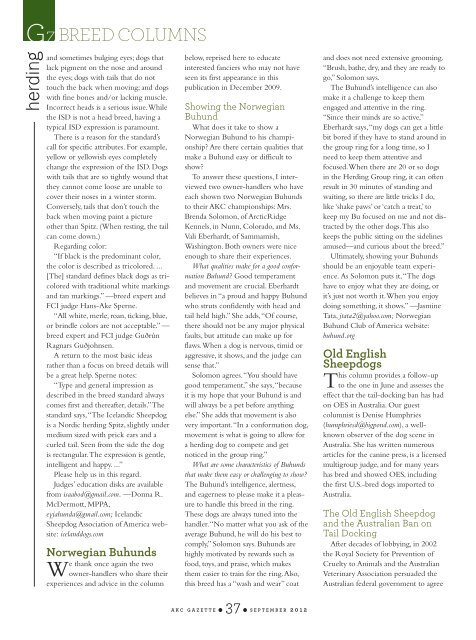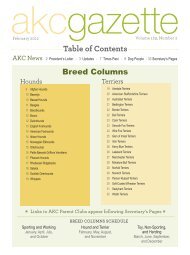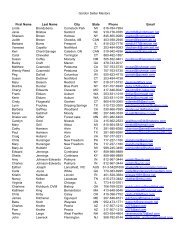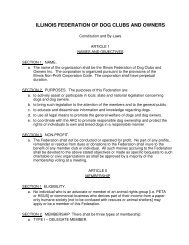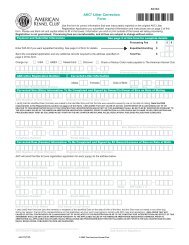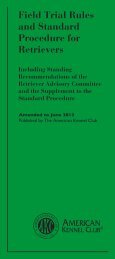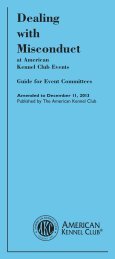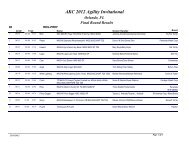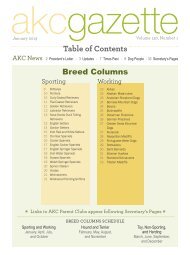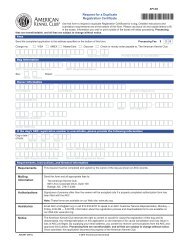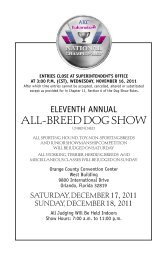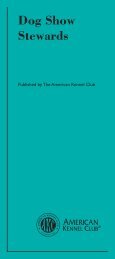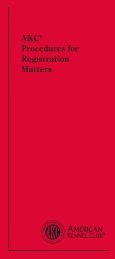Download - Parent Directory - American Kennel Club
Download - Parent Directory - American Kennel Club
Download - Parent Directory - American Kennel Club
- No tags were found...
Create successful ePaper yourself
Turn your PDF publications into a flip-book with our unique Google optimized e-Paper software.
GZ BREED COLUMNSherdingand sometimes bulging eyes; dogs thatlack pigment on the nose and aroundthe eyes; dogs with tails that do nottouch the back when moving; and dogswith fine bones and/or lacking muscle.Incorrect heads is a serious issue. Whilethe ISD is not a head breed, having atypical ISD expression is paramount.There is a reason for the standard’scall for specific attributes. For example,yellow or yellowish eyes completelychange the expression of the ISD. Dogswith tails that are so tightly wound thatthey cannot come loose are unable tocover their noses in a winter storm.Conversely, tails that don’t touch theback when moving paint a pictureother than Spitz. (When resting, the tailcan come down.)Regarding color:“If black is the predominant color,the color is described as tricolored. ...[The] standard defines black dogs as tricoloredwith traditional white markingsand tan markings.” —breed expert andFCI judge Hans-Ake Sperne.“All white, merle, roan, ticking, blue,or brindle colors are not acceptable.” —breed expert and FCI judge GuðrúnRagnars Guðjohnsen.A return to the most basic ideasrather than a focus on breed details willbe a great help. Sperne notes:“Type and general impression asdescribed in the breed standard alwayscomes first and thereafter, details.” Thestandard says, “The Icelandic Sheepdogis a Nordic herding Spitz, slightly undermedium sized with prick ears and acurled tail. Seen from the side the dogis rectangular. The expression is gentle,intelligent and happy. ...”Please help us in this regard.Judges’ education disks are availablefrom isaabod@gmail.com. —Donna R.McDermott, MPPA,eyjahunda@gmail.com; IcelandicSheepdog Association of America website:icelanddogs.comNorwegian BuhundsWe thank once again the twoowner-handlers who share theirexperiences and advice in the columnbelow, reprised here to educateinterested fanciers who may not haveseen its first appearance in thispublication in December 2009.Showing the NorwegianBuhundWhat does it take to show aNorwegian Buhund to his championship?Are there certain qualities thatmake a Buhund easy or difficult toshow?To answer these questions, I interviewedtwo owner-handlers who haveeach shown two Norwegian Buhundsto their AKC championships: Mrs.Brenda Solomon, of ArcticRidge<strong>Kennel</strong>s, in Nunn, Colorado, and Ms.Vali Eberhardt, of Sammamish,Washington. Both owners were niceenough to share their experiences.What qualities make for a good conformationBuhund? Good temperamentand movement are crucial. Eberhardtbelieves in “a proud and happy Buhundwho struts confidently with head andtail held high.” She adds, “Of course,there should not be any major physicalfaults, but attitude can make up forflaws. When a dog is nervous, timid oraggressive, it shows, and the judge cansense that.”Solomon agrees. “You should havegood temperament,” she says, “becauseit is my hope that your Buhund is andwill always be a pet before anythingelse.” She adds that movement is alsovery important. “In a conformation dog,movement is what is going to allow fora herding dog to compete and getnoticed in the group ring.”What are some characteristics of Buhundsthat make them easy or challenging to show?The Buhund’s intelligence, alertness,and eagerness to please make it a pleasureto handle this breed in the ring.These dogs are always tuned into thehandler. “No matter what you ask of theaverage Buhund, he will do his best tocomply,” Solomon says. Buhunds arehighly motivated by rewards such asfood, toys, and praise, which makesthem easier to train for the ring. Also,this breed has a “wash and wear” coatand does not need extensive grooming.“Brush, bathe, dry, and they are ready togo,” Solomon says.The Buhund’s intelligence can alsomake it a challenge to keep themengaged and attentive in the ring.“Since their minds are so active,”Eberhardt says, “my dogs can get a littlebit bored if they have to stand around inthe group ring for a long time, so Ineed to keep them attentive andfocused. When there are 20 or so dogsin the Herding Group ring, it can oftenresult in 30 minutes of standing andwaiting, so there are little tricks I do,like ‘shake paws’ or ‘catch a treat,’ tokeep my Bu focused on me and not distractedby the other dogs. This alsokeeps the public sitting on the sidelinesamused—and curious about the breed.”Ultimately, showing your Buhundsshould be an enjoyable team experience.As Solomon puts it, “The dogshave to enjoy what they are doing, orit’s just not worth it. When you enjoydoing something, it shows.” —JasmineTata, jtata2@yahoo.com; NorwegianBuhund <strong>Club</strong> of America website:buhund.orgOld EnglishSheepdogsThis column provides a follow-upto the one in June and assesses theeffect that the tail-docking ban has hadon OES in Australia. Our guestcolumnist is Denise Humphries(humphriesd@bigpond.com), a wellknownobserver of the dog scene inAustralia. She has written numerousarticles for the canine press, is a licensedmultigroup judge, and for many yearshas bred and showed OES, includingthe first U.S.-bred dogs imported toAustralia.The Old English Sheepdogand the Australian Ban onTail DockingAfter decades of lobbying, in 2002the Royal Society for Prevention ofCruelty to Animals and the AustralianVeterinary Association persuaded theAustralian federal government to agreeA K C G A Z E T T E • 37 • S E P T E M B E R 2 0 1 2


